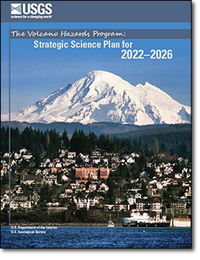The Volcano Hazards Program — Strategic Science Plan for 2022–2026
Links
- Document: Report (7.66 MB pdf)
- Download citation as: RIS | Dublin Core
Abstract
The U.S. Geological Survey (USGS) Volcano Hazards Program (VHP) Strategic Science Plan, developed through discussion with scientists-in-charge of the USGS volcano observatories and the director of the USGS Volcano Science Center, specifies six major strategic goals to be pursued over the next 5 years. The purpose of these goals is to help fulfill the USGS VHP mission to enhance public safety and to minimize social and economic disruption caused by volcanic eruptions in the United States and its territories, through delivery of effective forecasts, warnings, and information on volcano hazards based on scientific understanding of volcanic processes. These six major strategic goals are to (1) continue—and when possible, accelerate—implementation of the National Volcano Early Warning System (NVEWS); (2) improve community preparedness for volcanic hazards by updating and standardizing essential components of volcano hazard assessments and providing training to land managers, emergency responders, and State and local communities; (3) develop the next generation of volcano hazard assessments using geographic information systems and other digital tools; (4) make observations with new instrumentation and take advantage of advances in real-time gas sensors; (5) rebuild the Hawaiian Volcano Observatory and its monitoring capabilities; and (6) form new partnerships and strengthen existing partnerships with other government agencies and with academia and industry, to advance volcano monitoring, increase understanding of volcanic processes, and disseminate USGS information.
In its effort to advance volcano science and monitoring techniques, the VHP has identified six scientific targets to pursue over the next 5 years, including: (1) increased understanding of volcano seismicity; (2) improved probabilistic forecasting; (3) deepened grasp of volcano eruption histories and geochronology; (4) newly developed and refined physical models of magmatic systems, leading to better situational awareness and accuracy of eruption forecasts; (5) improved warnings and forecasts of volcanic ash and gas clouds and characterization of volcanic smog sources; and (6) refined lava-flow modeling and forecasting of lava-flow paths.
Suggested Citation
Mandeville, C.W., Cervelli, P.F., Avery, V.F., and Wilkins, A.M., 2022, The Volcano Hazards Program — Strategic Science Plan for 2022–2026: U.S. Geological Survey Circular 1492, 50 p., https://doi.org/10.3133/cir1492.
ISSN: 2330-5703 (online)
ISSN: 1067-084X (print)
Study Area
Table of Contents
- Executive Summary
- Introduction
- Alignment with the Natural Hazards Mission Area Strategic Plan (2013–2023)
- Alignment with the USGS 21st Century Science Strategy
- Volcano Hazards Program Mission Statement and Objectives
- Strategic Goals
- Scientific Targets
- Conclusions
- Acknowledgments
- References Cited
- Appendix 1. Comprehensive Volcano Hazards Program-Volcano Science Center Organizational Chart
- Appendix 2. A Brief Chronology of National Volcano Early Warning System (NVEWS) Legislation and Passage
- Appendix 3. Resources for More Information
| Publication type | Report |
|---|---|
| Publication Subtype | USGS Numbered Series |
| Title | The Volcano Hazards Program — Strategic science plan for 2022–2026 |
| Series title | Circular |
| Series number | 1492 |
| DOI | 10.3133/cir1492 |
| Publication Date | April 27, 2022 |
| Year Published | 2022 |
| Language | English |
| Publisher | U.S. Geological Survey |
| Publisher location | Reston, VA |
| Contributing office(s) | Office of the AD Hazards, Volcano Hazards Program |
| Description | vi, 50 p. |
| Country | United States |
| Online Only (Y/N) | N |
| Additional Online Files (Y/N) | N |


